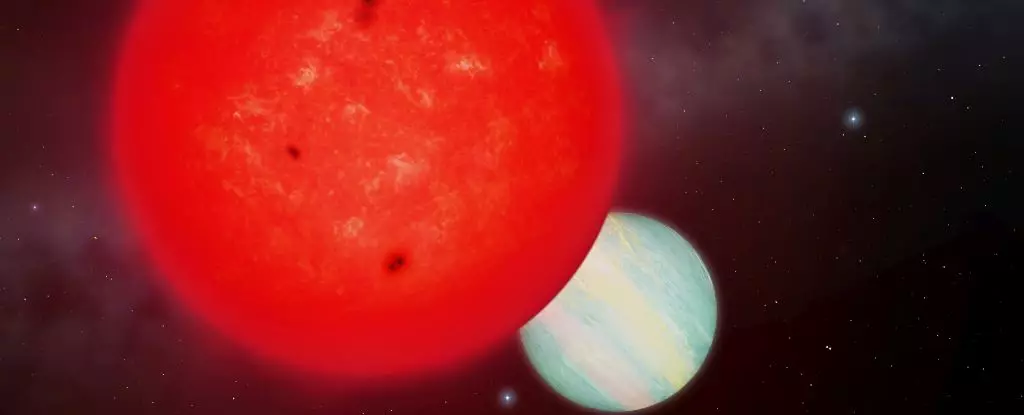In a remarkable twist in the journey of astronomy, scientists have stumbled upon an extraordinary gas giant, TOI-6894b, orbiting a diminutive red dwarf star. This discovery debunks long-held assumptions about planetary formation around low-mass stars, particularly the notion that these small stellar bodies lack the gravitational heft to dream up colossal companions such as this one. TOI-6894b boasts about 86 percent of Jupiter’s radius while existing in the orbit of a star barely a fifth the size of our Sun. What does this unexpected find mean for our understanding of planetary systems?
Red Dwarf Stars and Planetary Formation: A Conventional Wisdom Challenged
Traditionally, researchers have theorized that the mass of a star correlates closely with its ability to create planets. A larger star, brimming with gas and dust, is expected to deliver a wealth of material in the protoplanetary disk—laying the groundwork for robust planetary systems. In stark contrast, tiny red dwarf stars are generally considered unsuitable for generating giant planets due to their perceived lack of resources. TOI-6894, the parent star of TOI-6894b, is only 21 percent the mass of the Sun, and this exceptional find raises questions echoing through astrophysical communities: how can such a massive planet form around such a small star?
Edward Bryant, leading an extensive international team of researchers hailing from the University of Warwick in the UK, expressed his astonishment at this groundbreaking find. This gas giant challenges existing models, suggesting that we haven’t yet scratched the surface of understanding the complexities surrounding planet formation. What Bryant’s remarks hint at is a paradigm shift in how both scientists and the general public may need to view the lifecycle of stars and their accompanying planets.
Unveiling TOI-6894b: Tracking the Transit Phenomenon
The method employed to discover TOI-6894b was the transit technique, a trusted tool in exoplanet hunting. Astronomers carefully monitored the light emitted by TOI-6894 for the minute dips in brightness, signaling the presence of an exoplanet as it passed in front of its host star. While such transits usually only cause slight dimming, the team observed a substantial 17 percent reduction in starlight—an unprecedented amount for a star of such size. This situation allowed for precise calculations of the star’s dimensions and yielded the first pieces of insight into TOI-6894b’s atmospheric composition.
With TOI-6894’s relatively cool temperature, researchers expect to discover intriguing elements like methane in its atmosphere, something that would reveal a lot about its formation and structural makeup. The connection formed during these transits provides a unique opportunity to analyze the gases that could hold the key to unraveling the mysteries of TOI-6894b.
Towards a Revised Understanding of Planetary Genesis
The discovery of TOI-6894b prompts deeper inquiries into the processes that yield gas giants around red dwarf stars. Historically, theories surrounding the origins of such planets fell into two primary camps: one which envisions a step-by-step accumulation of solid material, gradually building up to form a gas giant, and the other favoring an abrupt gravitational collapse triggered by turbulence within the very disks where these planets form. Yet, neither model seamlessly fits the data presented by TOI-6894b.
Vincent Van Eylen, an astrophysicist from University College London, emphasizes the need for further investigations to unravel how a star with such diminutive mass could harbor a planet of astonishing size. As astronomers refocus their lens on this new planetary system, the potential to refine or redefine existing models becomes brighter.
A Groundbreaking Opportunity for Atmospheric Study
Not only is TOI-6894b remarkable due to its size and the nature of its host star, but it also serves as a prime candidate for atmospheric research. The depth of the transit implies significantly rich data can be gleaned, permitting scientists to filter the starlight passing through the planet’s atmosphere. This capability promises to shed light on TOI-6894b’s elemental makeup, potentially yielding insights into atmospheric phenomena that could reflect broader planetary formation narratives.
Research teams are already gearing up to utilize advanced instruments, including the James Webb Space Telescope (JWST), for atmospheric studies. The hope is that these explorations could further illuminate the factors affecting gas giant creation around stars that were previously deemed inadequate for supporting such colossal structures.
Through careful observation and innovative analytical methods, the intriguing case of TOI-6894b stands as a testament to the ever-unfolding richness of our universe, capturing the imagination of scientists and armchair astronomers alike. This discovery may indeed be just the beginning of a new chapter in astrophysical research, one that promises greater understanding of the intricate dance between stars and their planets.


Leave a Reply